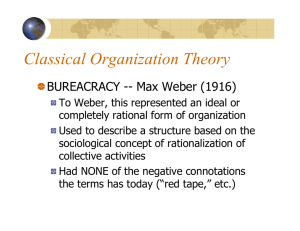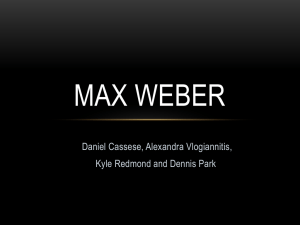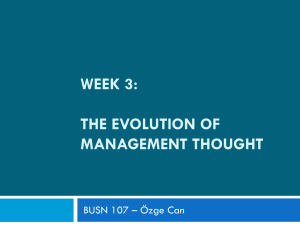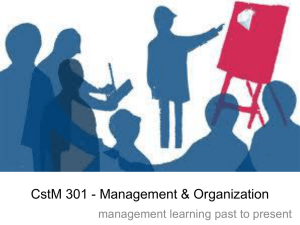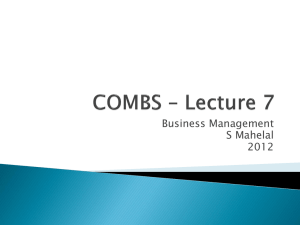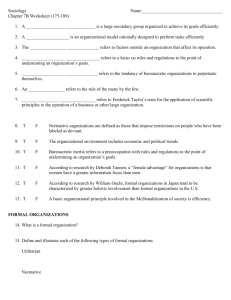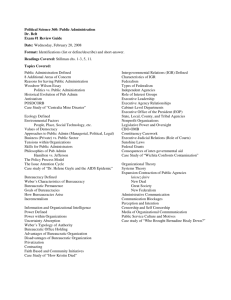Public Administration
advertisement
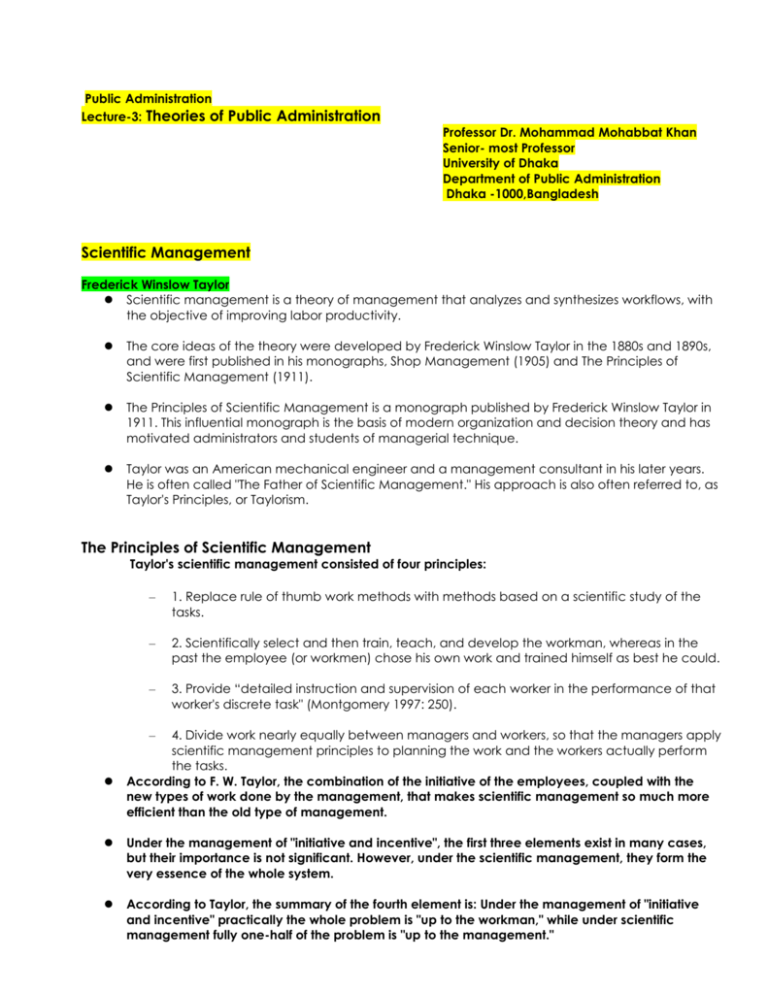
Public Administration Lecture-3: Theories of Public Administration Professor Dr. Mohammad Mohabbat Khan Senior- most Professor University of Dhaka Department of Public Administration Dhaka -1000,Bangladesh Scientific Management Frederick Winslow Taylor Scientific management is a theory of management that analyzes and synthesizes workflows, with the objective of improving labor productivity. The core ideas of the theory were developed by Frederick Winslow Taylor in the 1880s and 1890s, and were first published in his monographs, Shop Management (1905) and The Principles of Scientific Management (1911). The Principles of Scientific Management is a monograph published by Frederick Winslow Taylor in 1911. This influential monograph is the basis of modern organization and decision theory and has motivated administrators and students of managerial technique. Taylor was an American mechanical engineer and a management consultant in his later years. He is often called "The Father of Scientific Management." His approach is also often referred to, as Taylor's Principles, or Taylorism. The Principles of Scientific Management Taylor's scientific management consisted of four principles: – 1. Replace rule of thumb work methods with methods based on a scientific study of the tasks. – 2. Scientifically select and then train, teach, and develop the workman, whereas in the past the employee (or workmen) chose his own work and trained himself as best he could. – 3. Provide “detailed instruction and supervision of each worker in the performance of that worker's discrete task" (Montgomery 1997: 250). 4. Divide work nearly equally between managers and workers, so that the managers apply scientific management principles to planning the work and the workers actually perform the tasks. According to F. W. Taylor, the combination of the initiative of the employees, coupled with the new types of work done by the management, that makes scientific management so much more efficient than the old type of management. – Under the management of "initiative and incentive", the first three elements exist in many cases, but their importance is not significant. However, under the scientific management, they form the very essence of the whole system. According to Taylor, the summary of the fourth element is: Under the management of "initiative and incentive" practically the whole problem is "up to the workman," while under scientific management fully one-half of the problem is "up to the management." Classical Theory Henry Fayol Fayol was a key figure in the turn-of-the-century Classical School of management theory. Fayol proposed that there are five primary functions of management: (1) planning, (2) organizing, (3) commanding, (4) coordinating, and (5) controlling (Fayol, 1949, 1987). Controlling is described in the sense that a manager must receive feedback on a process in order to make necessary adjustments. Fayol's work has stood the test of time and has been shown to be relevant and appropriate to contemporary management. Many of today’s management texts including Daft (2005) have reduced the five functions to four: (1) planning, (2) organizing, (3) leading, and (4) controlling. Daft's text is organized around Fayol's four functions. The Fourteen Principles of Administration 1. Division of work: Reduces the span of attention or effort for any one person or group. Develops practice or routine and familiarity. 2. Authority: "The right to give orders. Should not be considered without reference to responsibility." 3. Discipline: "Outward marks of respect in accordance with formal or informal agreements between a firm and it's employees." 4. Unity of command: "One man one superior!" 5. Unity of direction: "One head and One plan for a group of activities with the same objective." 6. Subordination of Individual Interests to the Common Interest: "The interests of one individual or group should not prevail over the general or common good." 7. Remuneration of personnel: "Pay should be fair to both the worker as well as the organization." 8. Centralisation: "Is always present to a greater or lesser extent, depending on the size of the company and the quality of its managers." 9. Scalar Chain: "The line of authority is from top to bottom of the organization." 10. Order: "A place for everything and everything in its right place; ie. the right man in the right place." 11. Equity: "A combination of kindness and justice towards employees." 12. Stability of Personnel Tenure: "Employees need to be given time to settle in to their jobs, even though this may be a lengthy period in the case of some managers." 13. Initiative: "Within the limits of authority and discipline, all levels of staff should be encouraged to show initiative." 14. Esprit de corps (Union is strength): "Harmony is a great strength to an organization; teamwork should be encouraged." Fayol suggested that it is important to have unity of command: a concept that suggests there should be only one supervisor for each person in an organization. Like Socrates, Fayol suggested that management is a universal human activity that applies equally well to the family as it does to the corporation. Bureaucracy is the collection organizational structure, procedures, protocols, and set of regulations in place to manage activity, usually in large organizations and government. As opposed to adhocracy, it is represented by standardized procedure (rule-following) that guides the execution of most or all processes within the body; formal division of powers; hierarchy; and relationships are intended to anticipate needs and improve efficiency. Max Weber Max Weber has probably been one of the most influential users of the word in its social science sense. He is well-known for his study of bureaucratization of society; many aspects of modern public administration go back to him; a classic, hierarchically organized civil service of the continental type is — if perhaps mistakenly — called Weberian civil service several different years between 1818 and 1860, prior to Weber's birth in 1864. Weber described the ideal type bureaucracy in positive terms, considering it to be a more rational and efficient form of organization than the alternatives that preceded it, which he characterized as charismatic domination and traditional domination. According to his terminology, bureaucracy is part of legal domination. However, he also emphasized that bureaucracy becomes inefficient when a decision must be adopted to an individual case Weber's analysis of bureaucracy concerns: the historical and administrative reasons for the process of bureaucratization (especially in the Western civilization) – the impact of the rule of law upon the functioning of bureaucratic organizations – the typical personal orientation and occupational position of a bureaucratic officials as a status group – the most important attributes and consequences of bureaucracy can be seen in the modern world A bureaucratic organization is governed by the following seven principles: 1. official business is conducted on a continuous basis 2. official business is conducted with strict accordance to the following rules: 3. the duty of each official to do certain types of work is delimited in terms of impersonal criteria 4. the official is given the authority necessary to carry out his assigned functions 5. the means of coercion at his disposal are strictly limited and conditions of their use strictly defined 6. every official's responsibilities and authority are part of a vertical hierarchy of authority, with respective rights of supervision and appeal 7. officials do not own the resources necessary for the performance of their assigned functions but are accountable for their use of the resources 8. official and private business and income are strictly separated 9. offices cannot be appropriated by their incumbents (inherited, sold, etc.) 10. official business is conducted on the basis of written documents – – Critics of Weber’s Bureaucracy As Max Weber himself noted, real bureaucracy will be less optimal and effective than his ideal type model. Each of Weber's seven principles can degenerate. – – Competences can be unclear and used contrary to the spirit of the law; sometimes a decision itself may be considered more important than its effect; Nepotism, corruption, political infighting and other degenerations can counter the rule of impersonality and can create a recruitment and promotion system not based on meritocracy but rather on oligarchy; Even a non-degenerated bureaucracy can be affected by common problems: Overspecialization, making individual officials not aware of larger consequences of their actions Rigidity and inertia of procedures, making decision-making slow or even impossible when facing some unusual case, and similarly delaying change, evolution and adaptation of old procedures to new circumstances; A phenomenon of Catch-22 (named after a famous book by Joseph Heller) - as bureaucracy creates more and more rules and procedures, their complexity rises and coordination diminishes, facilitating creation of contradictory and recursive rules, as described by the saying "the bureaucracy is expanding to meet the needs of the expanding bureaucracy". In the most common examples bureaucracy can lead to the treatment of individual human beings as impersonal objects. This process has been criticized by many philosophers and writers (Aldous Huxley, George Orwell, Hannah Arendt) and satirized in the comic strip Dilbert, TV show The Office, Franz Kafka's novels The Trial and The Castle , Douglas Adams' story The Hitchhiker's Guide to the Galaxy, and the films Brazil and Office Space. Michel Crozier wrote the book The Bureaucratic Phenomenon (1964) to re-examine Weber's (1922) concept of the efficient and ideal bureaucracy in the light of the way that bureaucratic organizations had actually developed. Whereas for Weber, bureaucracy was the ultimate expression of a trend toward the efficient, rational organization, Crozier examined bureaucracy as a form of organization that evokes: "... the slowness, the ponderousness, the routine, the complication of procedures and the maladapted responses of the bureaucratic organization to the needs which they should satisfy" (Crozier, 1964, p 3) Crozier argues that: "... the bureaucratic system of organization is primarily characterized by the existence of a series of relatively stable vicious circles that stem from centralization and impersonality" (Crozier, 1964, p 193). – He outlines four such 'vicious circles' that he observed in the organizations he studied. – The development of impersonal rules – The centralization of decisions – The isolation of strata and group pressure within strata – The development of parallel power relationships According to Theodore Lowi, the relationships between the legislatures, the interest groups, bureaucrats, and the general public all have an effect on each other. Without one of these pieces the entire structure would completely change. Not one single piece can describe or control the entire process in this relationship. The legislatures, specifically lower houses, are elected by people and the interest groups represent and lobby for particular interests. Both the legislature and bureaucrats also have an effect on the interest groups and the public. The entire system is inter- dependent on each other. Human Relations School Elton Mayo Elton Mayo is generally seen as the founder of Industrial Sociology and the Human Relations School. His research on groups and behavior in work has had direct implications for management of organizations and for sociology. He studied a spinning mill in Philadelphia in USA and the Hawthorne Works of the Western Electric Company in Chicago, USA. The Hawthorne Experiment carried out between 1927 and 1932. Before Elton Mayo began there were experiments comparing two groups, one where lighting conditions were held static and one where lighting conditions were deliberately varied. Both groups increased their output! Mayo's team began their work in the Relay Assembly Test Room with six segregated female workers, who assembled telephone relays. Over five years changes were made and they were monitored for production and morale. There was always full discussion and consultation about the changes. No matter what happened, output increased each time. When, with consultation, the conditions went back to a 48 hour six day week without incentives, rest breaks and refreshments output reached a maximum. So, obviously, this had nothing to do with the material conditions and an instrumental explanation could not be sustained. What mattered was that the six had been consulted; they had a sense of freedom and control over the work rate; they were a self-referential interacting group; and the women in their cohesion and decision making were in effect rewarding the researchers for their interest in them with what they considered were desired increases in output. Then what is known as Bank Wiring Observation Room came under constant observation without any experimental inputs. These workers did the opposite, a group which held back their production and where no individual fell out of line. They did not respond to financial incentives. Basically, they collectively resisted the managers. However, again, this was an informal social group deciding its response on its own. So was Elton Mayo's explanation: that a principal unit of worker organization is informal, and that this transcends individual self- interest. The individualism of economics is wrong. Certainly satisfaction in the workplace comes from the informal social pattern mixed with the interest placed in them. The female workers assembling telephone relays felt important. The actual work conditions were not important in comparison. Equally the informal social group can resist dictates from one high with their cost and profit rationale. So was Elton Mayo's explanation: that a principal unit of worker organization is informal, and that this transcends individual self- interest. The individualism of economics is wrong. Certainly satisfaction in the workplace comes from the informal social pattern mixed with the interest placed in them. The female workers assembling telephone relays felt important. The actual work conditions were not important in comparison. Equally the informal social group can resist dictates from one high with their cost and profit rationale. Behavioral Approach The behavioral approach to management has two branches: the Human Relations Approach and the Behavioral Science Approach. In the human relations approach managers must know why their subordinates behave as they do and what psychological and social factors influence them. Advocates of this approach try to show how the process and functions of management are affected by differences in individual behavior and the influence of groups in the workplace. This approach requires managers to recognize employees’ needs for recognition and social acceptance and this results in training in human relation skills for managers. The Behavioral Science Approach • • The individuals in the behavioral science branch of the behavioral approach believe that the human is more complex than the “economic man” description of the classical approach and the “social man” description of the human relations approach. The behavioral science approach concentrates more on the nature of work itself and the degree to which it can fulfill the human need to use skills and abilities. • Mary Parker Follett (1868-1933) provided much of the management theories helping organizations recognize that they could be viewed form the perspective of individual or group behavior. She was a social philosopher whose writings provided a more people-centered view of the organization than the predominant scientific management writing. • According to Follett, the manager’s job was to harmonize and coordinate group efforts and managers and workers should view themselves as partners in a common project. Managers would act more from their knowledge of human behavior than from their positions in formal authority. Contributions of the Behavioral Approach include: increased use of teams to accomplish organizational goals, focus on training and development of employees, and the use of innovative rewards and incentive systems. In addition, the focus on modern management theory resulted in empowering employees through shared information. System Approach The systems approach to management is based on general systems theory – the theory that says that to understand fully the operation of an entity, the entity must be viewed as a system. This requires understanding the interdependence of its parts. The systems approach to management is a concept which views a company as an interconnected purposive system that consists of several business sections. It is a management approach which enables the leadership to see the company as a unified part or a major section of the larger outside corporate environment. The systems approach emerged as scientists and philosophers identified common themes in the approach to managing and organizing complex systems. Four major concepts underlie the systems approach: Specialization: A system is divided into smaller components allowing more specialized concentration on each component. Grouping: To avoid generating greater complexity with increasing specialization, it becomes necessary to group related disciplines or sub-disciplines. Coordination: As the components and subcomponents of a system are grouped, it is necessary to coordinate the interactions among groups. Emergent properties: Dividing a system into subsystems (groups of component parts within the system), requires recognizing and understanding the "emergent properties" of a system; that is, recognizing why the system as a whole is greater than the sum of its parts. Open vs Closed Systems – Some systems are open with respect to certain elements or processes. The elements or processes can flow into or out of the system. For example, an automobile engine is "open" with respect to gasoline--gasoline flows in and exhaust (oxidized gasoline) flows out. – Other systems are closed with respect to certain elements or processes. The elements or processes do not leave the system. For example, an automobile engine is largely "closed" with respect to lubricating oil--the oil does not leave the engine. – Ecological systems are open systems with respect to most elements and processes. They receive energy and nutrient inputs from their physical environment and, at the same time, cycle nutrients back out of the system. They are also open to outside influences such as disturbances (e.g., hurricanes, ice storms, fires, insect outbreaks).
